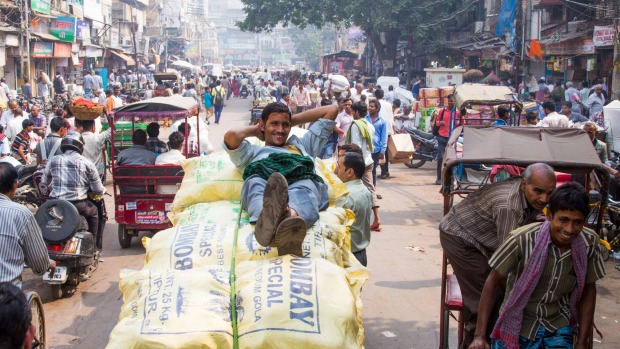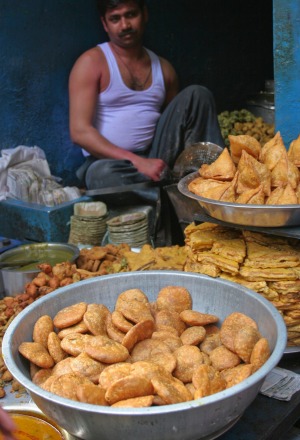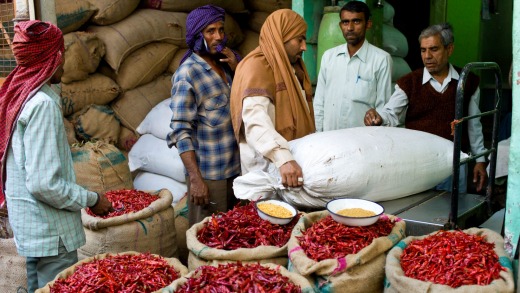
Ramit looks crestfallen when my friend and I inform him we are vegetarians. "Oh no!" he wails, dodging beggars, strewn garbage and sidewalk ear cleaners as he strides through the ancient marketplace of Chandni Chowk. "You're going to miss out on so many tasty treats! I wanted to take you to the Muslim section – oh my, the lamb, mutton, chicken – so good."
At the thought of such delectable offerings, our bespectacled guide has become a veritable Indian Homer Simpson, salivating with gleeful anticipation. Clearly this is a man who loves to eat, and the perfect person to lead us on a Foodies and Heritage walking tour.
His disappointment in our culinary restrictions, however, soon turns to excitement as he reconsiders his options. "OK, have I got a surprise for you," he says, rubbing his hands. "Just around this corner."

He stops in front of a street stall called Manohar Dhaba and directs us to a cluster of tables and chairs while he stands in line to order. He returns with a metal plate with two spoons, a variety of condiments and two unusual-looking pastries.
"These are Japanese samosas," he says, encouraging us to tuck in. "No one seems to know why they are called that – but they are made with 60 layers of pastry, a unique recipe and are very time-consuming to create. This stall has been here since 1949."
We bite into the flaky pyramid with a satisfying crunch, an explosion of spicy peas and potatoes stimulating our taste buds. Ramit watches carefully for our reaction, and is delighted with our satisfied expressions. "Not bad for eight rupees, hey?" A quick calculation – that's about 15 cents. Oh my, we're going to eat well today!

Until now, I've always been a little nervous about trying street food in India, fears of the dreaded "Delhi Belly" tempering my gastronomic spirit of adventure. Ramit's goal on this tour is to prove to us that food bought off the street in this ancient marketplace is not only safe to eat, but also innovative and delicious.
A passionate historian, Ramit is just as inspired by the stories behind the market stalls, many of which have been in existence since the 1800s. The famous Paranthe Wali Gali(Paranthe Alley), for instance, was originally known for its silverware shops, before a string of paranthe walas moved in during the 1870s. During its peak in the 1960s, there were 20 restaurants in this tiny laneway selling versions of the fried North Indian bread – only three remain, each one crammed with diners eagerly anticipating the crispy flatbread, freshly prepared in a street-front wok and served with dipping curries and condiments.
With a penchant for stodgy, high carb snacks, it amazes me that the people of India aren't a more portly race! One of their favourite sweets, for instance, is jalebi, a curl of dough deep-fried in bubbling oil and soaked in sugary syrup – pure, evil deliciousness! The name of the Old and Famous Jalebi Wala on the corner of Darina Kalan Road says it all – this humble stall has been in business since 1884, the sticky pretzels whipped up before your eyes in what amounts to culinary street performance.
With the midday thermostat searing, Ramit hails a bicycle rickshaw, hoping to speed our progress through the increasingly chaotic Chandni Chowk. Instead, we find ourselves trapped in a claustrophobic traffic jam, dozens of bikes competing wheel-to-wheel with bullock-drawn carts, taxis and garland-decorated trucks, horns blaring as larger vehicles assert their dominance. It's hilarious but terrifying, and we alight 20 minutes later outside Old Delhi Spice Market, quaking and grateful for our lives.
The largest in all of Asia, the wholesale spice market on Khari Baoli Road is pungent with the aromas of ground turmeric, cumin, nutmeg and nuts, piled high in colourful displays; while a section dedicated to chilli, bags of fiery red peppers stacked to the rafters, sets me sneezing uncontrollably.
Seeking respite, we are drawn into the airconditioned Mehar Chand and Sons to taste teas and buy spice samples pre-packaged to Australian custom regulations.
Despite protestations that we are fit to explode, Ramit promises a last snack that we won't be able to resist – a dessert called Mango Kulfi. Stepping into an unmarked, near-empty concrete space in a nondescript back alley, we are presented with slices of frozen mango, stuffed with a creamy filling thickened with rice flour. It's a veritable taste sensation, sweet and cooling and the perfect epilogue to our culinary adventure.
But Ramit has one more surprise up his sleeve. Beckoning, he leads us through massive wooden doors into a private haveli, recently restored to graciousness and now serving as a museum highlighting Old Delhi's role as a centre of urban life. Ushering us to a cane dining setting, the mansion's owner leaves us to explore the courtyard's shaded porticos, returning with the nation's favourite beverage and the traditional way to conclude a magnificent feast: masala chai, brewed black tea blended with spices and served hot and sweet.
incredibleindia.org.
Air India flies from Sydney via Melbourne daily to Delhi, see airindia.in.
Mantra Wild Adventures offers a four-day Delhi Food and Heritage tour, including three nights at a luxury boutique hotel with breakfast, transfers and tours, priced from $899. The walking tour can be bought separately for $180. Phone 1300 036 782; see mantrawild.com.au.
The writer was a guest of Mantra Wild Adventures.